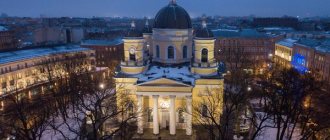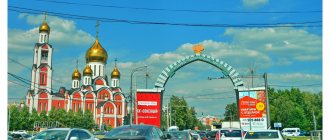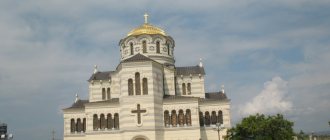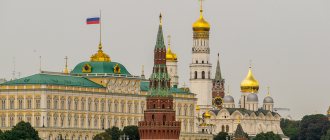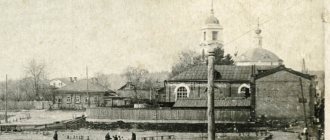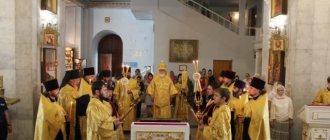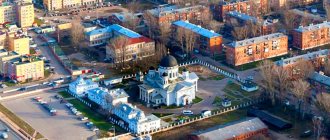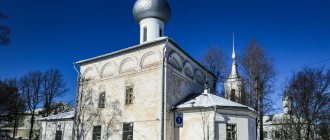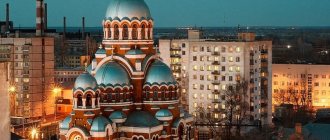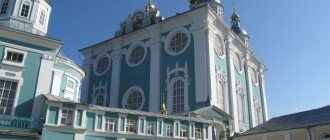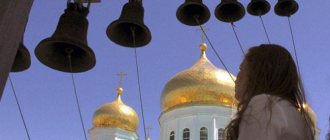If you are lucky enough to visit Riga, your attention will certainly be drawn to the most recognizable symbol of the Latvian capital - the Riga Dome Cathedral (Rīgas Doms).
The largest cathedral in the Baltics, the Dome Cathedral is one of the leading spiritual and cultural centers of Latvia.
The cathedral is the main temple of the Evangelical Lutheran Church; Concerts of organ and sacred music are held here. It is located in the very heart of Riga - on Dome Square. The architectural ensemble of the cathedral also includes the Cross Gallery and the Dome Monastery, on the territory of which the oldest city museum is located - the Museum of the History of Riga and Navigation.
Surprisingly, but true: the Dome Cathedral is located below ground level. If earlier you climbed steps into the cathedral, now, to approach the northern portal of the building, you need to go down 16 steps.
This metamorphosis was caused by the struggle of the townspeople with the floods of the Daugava - every year they poured gravel onto the streets of the city, and the cathedral “sank” lower and lower.
The name of the cathedral was given by two Latin expressions - Domus Dei (House of God) and an abbreviated version of DOM from Deo Optimo Maximo (All-Good Greatest God).
History of the cathedral
Construction of the cathedral began 8 centuries ago, in 1211, on the orders of the Bishop of Riga Albert (Albrecht von Buxhoeveden). The temple was supposed to symbolize success in the conquest of Livonia.
The solemn ceremony of laying the foundation of the cathedral in honor of St. Mary on the site of the burnt Liv fishing village took place on July 25, St. Jacob's Day.
The building was erected by local builders under the guidance of invited German and Dutch craftsmen. The chief priest spared no expense and personally supervised the progress of construction. However, construction dragged on for many decades.
The founder of Riga, Bishop Albert, who died in 1229, was buried in the unfinished cathedral “under the third stone, under the lamp.” Albert's grave has not yet been found.
In this regard, there is a legend about an underground passage from the altar of the cathedral, leading to a dungeon with countless treasures. The dungeon plan and the key to the passage are in the Vatican.
Having undergone significant changes to the original plan, the cathedral as a whole was completed by 1270. The interior of the temple was destroyed after the Reformation and the fire of 1547. In the same year, the cathedral tower was built.
Half a century later, it was built on and a wooden spire was erected, which survived 4 lightning strikes and stood until 1766.
About 200 years ago, at the end of the 18th century, the cathedral acquired its current appearance. After another reconstruction of the tower in 1776, a small domed spire in the Baroque style, topped with a cockerel, was built above it.
The uniqueness of the cockerel was that one side was golden and the other black. This figure predicted the wind and the success of trade.
Experts explain the blackening of the cockerel by the influence of the humid marine climate. Today, the cockerel, which survived two world wars, is kept in the Cross Gallery.
Thanks to multiple reconstructions, the appearance of the Dome Cathedral organically intertwined elements of various architectural styles - Romanesque, early Gothic, Baroque, Renaissance and Art Nouveau (Art Nouveau).
Do you know which attractions in Riga you should definitely visit? Read our article. When planning a trip to Riga, you should definitely visit Sigulda. This article tells about this interesting place with old castles and a National Park.
Newer churches in Riga
From monuments of ancient times, let's move on to churches that are newer, but no less interesting and extremely beautiful.
Church of Our Lady of Sorrows
Story
Founded in the second half of the 18th century, the church was originally a very modest structure, but after indignation and a generous donation from Archduke Joseph II, the church began to be rebuilt. Thanks to the broad gesture of the august person, other representatives of the nobility, including Russian, as well as wealthy landowners, also began to invest money in the church. Well, now all we can do is thank them for the opportunity to see this beautiful building, which has survived to this day in its original form. The thirty-five-meter-tall beautiful church stands out as a bright spot in any weather with its eclectic decoration. The delicacy and restraint of the structure do not inspire the emotions that churches were once supposed to show. Instead of fear and a reminder of the inevitable, this church looks more like a corner of peace and light.
Opening hours
The Church of Our Lady of Sorrows is a functioning temple where services are held in Latvian, Polish and Russian. Also in the church, of course, baptisms and weddings take place. I even once had the opportunity to attend a wedding in this church. My age then, however, did not allow me to appreciate the whole picture and analyze it properly, but I still remember the sincere childish delight. The high, light vaults and beauty reached my childhood brain.
So, the schedule of services is very busy and I think it will be more convenient for you to check it on the website.
Other events are associated with church holidays and occur infrequently. The calendar does not include any church choir performances, but you may be lucky enough to catch one.
The first service in the church begins at 7:00, and the last at 18:00, so you can quietly pop into the church and take a look at the interior decoration.
How to get there
The Church of Our Lady of Sorrows is located near the Riga castle on the castle square. If you explore the fortress, you will definitely notice this light blue building. However, since we took Town Hall Square as our starting point, then if you please:
The map offers you three routes. If you are afraid of getting lost, the easiest way is to walk along the embankment and turn right at the intersection with the Polish Gate (Poļu gāte) street. Another option is to walk along Small New Street (Māza Jauniela), continue along New Street (Jauniela) (yes, no imagination), and then exit along Tirgon or Kram to Dome Square and from there walk along Castle Street (Pils iela) . The route should be built in competition with other museums in Riga, as well as historical monuments that you want to visit.
Church of Mary Magdalene
Another Catholic church is very close.
Story
The history of the Church of Mary Magdalene, in contrast to the Church of Our Lady of Sorrows, is much more eventful. The church was initially mentioned in the 15th century, but, as often happens, it was rebuilt in 1639. Afterwards she changed her confession and purpose several times. Initially, a Catholic convent turned into a Lutheran Swedish garrison church, and then was converted into an Orthodox monastery. The backlash stopped in 1923, when the church was again classified as Catholic, which it remains to this day.
The period of reconstruction and further changes associated with the changes led to the fact that the church is a Baroque building, although the work was carried out in the second half of the 18th century.
Opening hours
Now the church is active and open every day from 6:30 to 20:00. Unfortunately, the church does not provide information about services, but what’s stopping you from just looking into this building with such a controversial past?
How to get there
To get to the church you need to pass Dome Square, then follow Jekāba iela, turn onto Malaya Zamkova (Māza Pils iela) and turn onto Monastyrska street (Klostera iela).
If you get to the Church of St. James, then the church will be very close, look for it by the Baroque spire.
Old Gertrude Church
Story
Despite the fact that there are mentions of this church already in the 15th century, and the area for it was allocated precisely then, the temple that can be admired now was built in the 19th century according to the design of Johann Felsko, a famous Riga architect, a graduate of the St. Petersburg Academy of Arts. The church was consecrated in 1869.
The outside of the church is made of red brick, which gives it a resemblance to ancient buildings, while the interior is light, decorated with ornaments and rather laconic decorations. The church stands on a small square, surrounded by buildings of very different dates. Modern “neighbors” are covered with glass panels, so that they not only do not stand out from the ensemble, but, on the contrary, modestly reflect the facade of the church, this is especially noticeable on sunny days.
Events and opening hours
The church hosts organ music concerts (about 2-3 times a month), admission to the concert is for a donation. You can also attend concerts of choral singing or individual performers. The price in this case may fluctuate, but on average tickets will cost approximately EUR 10.00.
The temple is active and on Thursdays (at 19:00) and Sundays (at 10:00) liturgies are held, and on the first and third Sundays at 18:00 there are services where you can confess and receive communion.
The temple is open on Monday and Tuesday from 10:00–14:00, on Wednesday and Thursday from 14:00–19:00, and on Sunday from 9:00–14:00. The temple is closed on Friday and Saturday, so keep this in mind if you want to look inside.
How to get there
Well, this church is no longer “close” to the old city, so you’ll have to take a walk. You will need to go out to Brivibas Street and walk along it to Gertrude Street (Ģertrudes iela) to look to the left and immediately see the purpose of your visit.
How to get to Brivibas Street and why else it’s worth walking along it can be read here.
New Gertrude Church
Story
The younger “sister” of the old Gertrude Church was built in 1906 and is located at a relative distance from the old city. This year the church celebrates 110 years, which, in general, is quite a lot, although it cannot yet compete with the first churches.
Built in the neo-Romanesque style, this church, however, is not devoid of the influences of Art Nouveau, which dominated architecture at that time. This translates into one of the best features of style: comfort. The church is quite conveniently located, and the internal layout allows it to accommodate a large number of people. The interior decoration, however, is quite modest, but this does not at all interfere with enjoying the high arches and silence at times when there are no services. In general, the church, standing on the main street of the city, is a kind of haven of peace and timelessness.
Opening hours
Divine services are held on Sundays at 11:00 and 16:00 (in Russian), as well as on Thursdays at 19:00.
The church is open on Wednesdays from 11:00–13:00, on Thursdays from 13:30–18:30, and on Fridays from 11:00–13:00.
I was somehow lucky to get to a short rehearsal before the Christmas concert and, hiding from the rain and listening to the musicians rehearsing under the echo of the vaults, I experienced a surprisingly pleasant feeling of peace. And they greeted me there warmly, only saying that there was no service.
How to get there
To get to the New Church of St. Gertrude, you need to move further along Brivibas Street, away from the center, and soon a red spire will open to your gaze. You can also get to this church by public transport: buses 1, 14, 16, 21, and 40, as well as trolleybuses 12, 14 and 17. In general, take what you see.
Cathedral interior
The modern interior of the Dome Cathedral was mainly created in the last quarter of the 19th century, during the revival of the temple.
The modest interior decoration of the temple is made in the Gothic style. The magnificent stained glass windows in the Gothic windows of the building leave no one indifferent.
These paintings from pieces of colored glass, created by talented craftsmen more than a hundred years ago, recreate scenes of the laying of the first stone of the cathedral, the meeting of the Swedish king, and the proclamation of freedom of religion in 1525. Some of the stained glass windows were lost during the Second World War.
Wood carvings from the Middle Ages have been preserved in the cathedral: two benches are decorated with paintings “Adam and Eve in Paradise” and “St. Mary”, a carved pulpit in the Baroque style of the mid-17th century.
The northern entrance of the cathedral is decorated with the “Paradise Portal” with a picturesque depiction of the coronation of Mary.
Famous Dome stained glass windows
The stained glass windows that currently exist were made in the late 19th - early 20th centuries, during the period when restoration took place in the church ensemble. The restoration was carried out with money from donations.
On one of the stained glass windows you can currently see the Madonna with a baby in her arms and representatives of the Tiesenhausen family. The stained glass windows also depict Bishop Albert and the first builders of the Dome Church.
The ensemble of the Riga Dome Cathedral houses one of the oldest museums in Latvia - the Museum of the History of Riga and Navigation . The museum was founded in 1773 on the basis of the private collection of the doctor Nikolaus von Himsel. The museum contains exhibits related to the history, culture and life of Riga, as well as a valuable collection on the history of Latvian navigation. Entrance to the museum is paid, 3 euros for an adult ticket. Official website of the Museum of the History of Riga and Navigation: https://www.rigamuz.lv/km/index.php.
To the right of the main entrance to the Dome Cathedral there is a monument to the German philosopher-educator, writer and folklorist Johann Gotfrids Herders , 1744-1803.
Johann studied theology at the University of Königsberg (1762-1764). From 1764 to 1769 he was a teacher at the Dom School, teaching natural sciences, mathematics, French, stylistics and history. Developed the idea of continuous progress in human history and the progress of society towards humanism, with special emphasis on common sense and justice.
Organ of the Dome Cathedral
The real pride and true decoration of the Dome Cathedral in Riga is its organ, which has become a kind of musical emblem of Latvia.
The Dome organ is one of the most valuable historical instruments in the world. At the time of its creation, it was the largest in the world, and today it is one of the largest bodies in Europe.
The first organ was built in 1603, serving for almost three centuries. In 1883-1884, German craftsmen from Ludwigsburg manufactured and installed a new organ, the sound of which can still be heard today.
Its dimensions cannot fail to impress : the width of the instrument is 11 m, and the height is comparable to a nine-story building (25 m). The design, which has 124 registers, includes 6718 pipes ranging in length from 13 mm to 10 m.
The avenue, a multi-tiered frame around the central part of the organ, has unique artistic value. It is made in the early Baroque (Mannerist) style and dates back to 1599-1601.
Figures of angels, fancy animals and flower garlands are woven into a single stunning pattern using filigree carvings.
Like the temple itself, the organ was rebuilt and restored several times. At the beginning of the 20th century, the lower balcony was demolished, and the pipes from it were moved to the very top of the instrument. In 1962, that were lost during the Second World War recreated
In the 1980s Dutch specialists carried out the restoration of the organ, returning two balconies with control panels installed on them. The avenue is currently being restored and there is scaffolding inside the cathedral.
The outstanding Hungarian composer Franz Liszt wrote the composition “Praising God” especially for the organ of the Dome Cathedral.
The distinctive features of the organ are multicolored and rich sound, because it is capable of conveying the sound of any musical instrument, the sound of wind and waves.
The excellent acoustics of the Dome Cathedral allow listeners to enjoy the unique beauty of the sound of this amazing instrument.
Orthodox churches in Riga
Despite the fact that Lutheran churches predominate in Riga, the city also has a sufficient number of Orthodox churches, which not only serve as a stronghold for believers of this denomination, but also add variety to the Gothic profile of the city. Onion domes or spherical domes and rich Orthodox Baroque fit surprisingly organically into the city.
Nativity of Christ Cathedral
The richly decorated Cathedral of the Nativity of Christ shines with golden domes among the greenery of the park. You will definitely see it if you walk along Brivibas Street or approach the Freedom Monument. Restored, refreshed, one of the central churches of Orthodoxy in Riga, this cathedral, despite its relative youth (it was built in 1884), managed to survive many troubles.
Story
In 1917, when Riga was occupied by German units, the cathedral was converted into a Catholic church, then parts of the cross were cut down so that it would lose its distinctive Orthodox features. The following years were no less difficult. The cathedral was closed and then reopened. By 1930 it had gained strength again and regular services resumed there, even during the German occupation. After the war, the temple remained active until 1963, when the Soviet government converted the temple into a youth house of knowledge, and a planetarium was located under the dome. It’s quite strange now, going into church, to hear from my parents that in their youth they went here to look at the locations of the constellations.
By 1992, the temple was returned to believers and has been in operation ever since.
Opening hours
The cathedral is open from 7:00 to 19:00 every day. Services are held on weekdays at 7:30 and 17:00, on Sundays and holidays at 7:00, 9:00 and 17:00.
How to get there
As I already wrote, it is very easy to find the cathedral: it is clearly visible from the Freedom Monument, and to get to it, you just need to follow the domes along Brivibas Street.
Alexander Nevsky Church
The Alexander Nevsky Church, also located on Brivibas Street, is an example of classicism architecture, built in 1825 as a memorial in honor of the victory over Napoleon. The temple has a round shape, with a rotunda reaching 11 meters in diameter. The church is included in the UNESCO cultural heritage list, and celebrated its 190th anniversary in 2015.
Its interesting feature is that the church is built of wood and plastered. Fortunately, since its construction, this church has never suffered from fire, time, or human hands.
Opening hours
At the moment, the temple is active and is open every day from 8:00–20:00. Services are held at 8:30 and 18:30 on weekdays, and at 9:00 and 18:00 on weekends.
How to get there
To find the Church of Alexander Nevsky, you will need to walk further along Brivibas Street, already known to you, and, almost reaching the intersection with Lačpleša Street, you will see the newly restored yellow facade of the church.
Holy Trinity Sergius Monastery
Originally created as a shelter for girls and elderly women, in 1907 it turned into a magnificent cathedral, named after the Holy Trinity. Initially, the temple was a monastery, but in 1961, due to the closure of the Nativity Cathedral, it turned into a cathedral. Now the cathedral has again acquired monastic status. It houses various shrines, as well as revered icons of the Most Holy Theotokos and Seraphim of Sarov.
Opening hours
To this day, the cathedral remains active, with services held daily at 8:00 and 17:00 on weekdays, and at 7:00, 9:30 and 17:00 on Sundays and holidays.
How to get there
To get to the Holy Trinity Monastery, you need to move along Krishjan Barona Street, and on the right side you will see the cathedral peeking out from behind the tops of the trees.
Church of Peter and Paul
This building is relevant to this article rather because of its historical affiliation. Built in 1786, the church was long an Orthodox church, but in 1987 the church was restored and rebuilt into the Ave Sol concert hall.
Despite the fact that the interior decoration has completely moved away from the church, from the outside the church is still quite similar to a temple built in the style of classicism. Well, services are no longer held here, but concerts of classical and jazz music are held (although I remember that a gypsy ensemble once performed there. How to feel about this is a personal matter for everyone, I suppose).
How to get there
To get to the Ave Sol hall, you will need to walk just past the Cable Bridge towards the Quiet Center. You can walk along the embankment and turn onto Muitas iela, and then walk along Citadeles iela. You can also go through the Old City, but then you will still need to go to the Citadel.
Anglican Church
Rare in its denominational affiliation, the Anglican Church, with its red Gothic façade facing the waterfront, was founded as a church for British sailors back in 1859. Erected according to Gothic canons, this church served its intended purpose for a long time. During the Second World War, as well as during Soviet times, the church changed its denominational affiliation, and after that it completely turned into a student dormitory (a throwback to that time is the Lasīte (“Droplet”) café, which has survived to this day. In 1992, the church again returned to the Anglican parish, and since 1998, services and organ music concerts have been resumed in the church.
Church services are held every Sunday at 11:00 in English.
The church also hosts concerts (the poster can be found on the website).
How to get there
To get to the Anglican Church, you can either walk through the central part of the city along Maza Jauniela Street, then along Palast, Episcopal (Bīskapa iela) and, looking at the embankment, dive into Anglican Street (Anglikāņu iela).
Official sects
New Generation
Must be one of the oldest sects in Riga. Frankly speaking, I can’t say anything bad about them from personal experience. I remember that they once supplied newspapers to our school (this was already about twenty years ago), since then this trend has not manifested itself in any way in my life. The church has a building in which services are held. It is located in Zadvinye (non-central part of the city).
Revelation
The Revelation Church is a representative of the evangelical Christianity that came to Latvia in 1949. Despite its long history, this religious community was completely invisible in a secular state; moreover, it has about 300 members. Under the auspices of "Revelation", however, in 2015 a children's center for children from disadvantaged families was opened in Liepaja.
Mormon churches
Among others, there are several Mormon parishes in Riga, although official data on their location could not be found. Parishes host free English courses, as well as seminars on a wide variety of topics. Missionaries can often be found on the streets of the city, they are polite and try their best to speak either Russian or Latvian, but are extremely happy if you want to carry on a conversation in English.
Current state of the cathedral
Today the pearl of Riga is under threat of destruction . The cathedral is included in the list of 100 world monuments on the verge of extinction.
The reason for this condition is the deterioration of the structures over the 800 years of the cathedral’s existence, and violations of technology during restoration work. The building is gradually settling, the cathedral tower is tilted 63 cm from the vertical. Due to the deformation of the tower, the bells were removed from it.
Now the Dome Cathedral stands in scaffolding: in 2011, a large-scale restoration of the entire architectural complex began, designed to last 10 years.
Modernity
Since the 1980s, the cathedral has been under restoration. Full-scale restoration work on the Dome Cathedral and the adjacent monastery, financed by the European Regional Development Fund and the Latvian Evangelical Lutheran Church, began in 2011 (the restoration project manager is Roland Lusis). The reconstruction should last 10 years, initially it was planned to invest 38 million lats in it. In the first two years, it was planned to restore the roof of the cathedral, its tower, facades, stained glass windows, as well as part of the interior.
How to visit the Dome Cathedral
Finding the cathedral is very simple: it is located in the very center of Riga , on Dome Square, 1. The building is one of the high-rise dominant features of this part of the city. The golden cockerel crowning the spire of the Dome Cathedral can serve as a landmark
The spire of the Dome Cathedral (like three other ancient Riga churches) is crowned not by a cross, but by a cockerel. It served a dual role - it protected from evil and scared away the evil one, and also served as a weather vane, showing the direction of the wind to numerous sailing ships in the port.
Architectural features
The initial construction of the cathedral was carried out by Dominican monks. They laid not only the foundation, but also the format of the building. Therefore, further reconstructions, which significantly changed the cathedral, still could not deprive it of the laconicism and severity characteristic of the Gothic style.
Today, the Dome Cathedral is a structure with three naves and an altar, which is a continuation of the central nave. Above it is a bell tower, the 69-meter height of which allows you to admire the wonderful panorama of Tallinn. In addition, there is an observation deck open to visitors.
The walls of the temple correspond to the general style. They are decorated with arched narrow windows, complemented at the top with elegant thin carvings reminiscent of lace. Notes of lightness in the strict architecture are introduced by the altar slate, made in the shape of a pentagon, the octagonal small tower crowning the spire on the central nave, and small southern extensions.
The tower weather vane, decorated with a lily, which has long symbolized the purity and chastity of the Virgin Mary, is also very interesting. Since from a distance it resembles a crown, legends say that it was installed as a thank you to Empress Catherine.
Concerts in the Dome Cathedral
Organ music concerts are held in the concert hall of the Dome Cathedral . Their schedule can be viewed on the official website of the Dome Cathedral - https://www.doms.lv.
Tickets costing from 7 to 15 euros are sold at the cathedral box office; it is better to take care of them in advance.
Every year at the beginning of July the International Organ Music Festival “Rīgas Doms” takes place here. Fans of classical music will truly enjoy the performances of the world's leading organists.
In December, a traditional Christmas market takes place on the square in front of the Dome Cathedral, where you can buy original souvenirs and gifts.
If you have a long vacation in Latvia, then you can take the Riga-Stockholm-Riga ferry and in two days also take a ride to Sweden and back. Be sure to visit Jurmala and get acquainted with its sights with the help of our material, it is really very beautiful there.
One of the many available entertainments is a visit to the water park, it is located very close to Riga, find out more in this article: https://vpribaltike.com/latviya/yurmala/mesta-yurmali/livu-akvapark-v-yurmale.html
Through me
Well, you read about the oldest city churches of two significant religious denominations. Churches are interesting to visit regardless of your religion and worldview. As I have already said, vanity and strife are no longer of interest to these titans, who sleep steadily in their memories, reminiscent of museums rather than temples. Touch them, they are very complacent.
If you are lucky enough to be in Riga on holidays such as Museum Night (usually held in the spring. In 2021 it will be held on May 21) or the Staro Rīga light festival (timed to coincide with Independence Day, November 18), then you will have a chance to visit some churches and after sunset (as a rule, St. Peter's Cathedral and often St. John's Church are open). I recommend taking advantage of this opportunity. Firstly, there are often interesting performances of light and music, and secondly, in the dark, even with crowds, you get the feeling that you are not looking at the church, but the church is looking at you with its wise, time-worn pupils.
